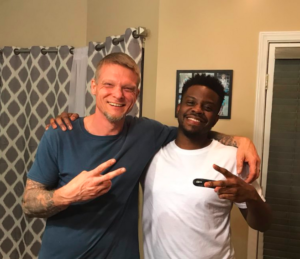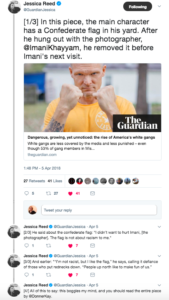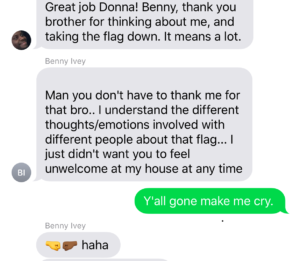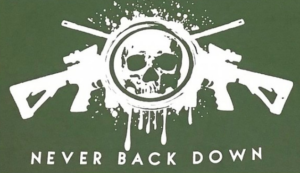
One of the sections in my Guardian story on Benny Ivey and white gangs that I’m hearing the most about is when I report near the end about how the former gang leader had a Confederate flag in his garage over his weight set, but had removed it by the time my “partner in crime prevention”—as photographer Imani Khayyam and I call each other—returned with me in December to photograph Benny at his home after we both followed him to church with him and his wife that morning. By then, Imani and Benny had gotten to know each other on a long driving tour of his old haunts in South Jackson and Rankin County, including houses he had broken into and where his friend had killed himself with Benny’s gun and sitting on his bed.

Benny and Imani had hit it off immediately with similar senses of humor. (Both are very funny and sociable.) Benny had talked freely about race within the gangs and prison in front of Imani. Imani had even joked that his mama was gonna be mad because he was going to church with some white guy instead of her. A generation apart in age, they had figured out that Imani grew up in a house in South Jackson after the area had turned mostly black that was near where Benny’s family lived when it was still whiter. (I used to fix white aunts and uncles around there a generation before Benny when it was all-white. We represented several stages of white flight of South Jackson, all in one SUV.)
I hadn’t told Imani about the flag—neither of us are fans of it—and I didn’t mention it when I saw that it was gone on that visit. But later on the phone with Benny, I asked him about it, and he explained why he liked it—it wasn’t about racism, but defiance of all the northerners who look down on rednecks, he said—which I decided to put into the Guardian story. Benny also told me he had taken the flag down when he knew Imani was coming because he didn’t want to hurt him. At first, I didn’t put that into the Guardian draft, but decided to add it just before it went to press. I’m very happy I did, and apparently so is Jessica Reed, my editor, as you can see from her Twitter thread embedded here.

On the morning my Guardian story about Benny went live, I texted Benny and Imani together to tell them it was live. Benny said he had seen it go up at 5 a.m. and already had it on his Facebook page. Imani said he’d read it, as he hadn’t seen it yet. Soon, after reading what Benny told me about taking the flag down, Imani texted us both back saying, “Benny, thank you, brother, for thinking about me, and taking the flag down. It means a lot.”
Benny texted him back: “Man, you don’t have to thank me for that, bro. I understand the different thoughts/emotions involved with different people about that flag. I just didn’t want you to feel unwelcome at my house at any time.” Benny then added a black and a white hand emoji fist-bumping. Imani responded with black prayer hands, then “my brother forever!”
I don’t offer this story as an easy answer to difficult race questions, but it does illustrate how important building honest, open relationships across divides can be to bridging gaps, I think.

